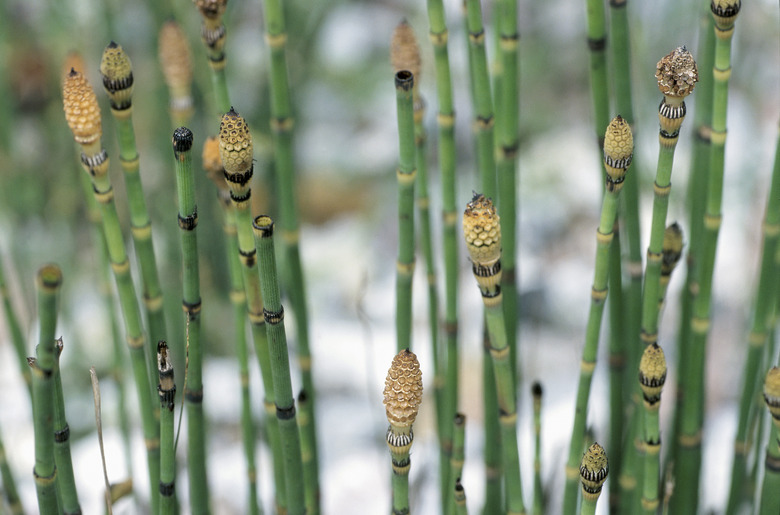How To Kill Scouring Rush Horsetail
Scouring rush horsetail, part of the Equisetum species of plants, is invasive in many parts of the United States. It grows as tall slender reeds, the souring rush variety having a smooth almost bamboo-like stalk. The stems are typically a half-inch in diameter and can reach to 5 feet tall if they aren't controlled. Scouring rush horsetail is hard to control because the plant is an evergreen and has an extensive root system.
Step 1
Examine the tops of the scouring rush horsetail stems to see if they have a small cone-like growth, which contains the seeds. If cones are present, cut them off with hand pruners and place them into a trash bag to prevent the spread of seeds.
Step 2
Drag a bow rake over the entire area where the scouring rush horsetail is growing to scar and cut the stems slightly. This allows the herbicide to penetrate the hard outer shell.
- Scouring rush horsetail, part of the Equisetum species of plants, is invasive in many parts of the United States.
- Scouring rush horsetail is hard to control because the plant is an evergreen and has an extensive root system.
Step 3
Fill a backpack sprayer or hand-held garden sprayer with a glyphosate-based herbicide. Read the bottle and use the amount specified for your size of infestation. Add water to the sprayer to dilute the mixture to 2 percent herbicide.
Step 4
Close the sprayer and don protective gear including safety glasses, gloves and a dust mask.
Step 5
Spray the herbicide solution onto the scouring rush horsetail weeds until all portions of the stem are damp. Avoid spraying the herbicide on other areas of the lawn, as it kills all vegetation.
Step 6
Wait a week and examine the scouring rush horsetail to see if it's brown. Retreat any weeds that remain green.
- Fill a backpack sprayer or hand-held garden sprayer with a glyphosate-based herbicide.
- Add water to the sprayer to dilute the mixture to 2 percent herbicide.
Kill Scouring Rush Horsetail
Cut scouring rush and horsetail as soon as it emerges and remove the cone-like tips of the plants' stems to short-circuit spore production. Dig plants up several times during the season. Equisetum roots may reach as deep as 6 feet, so repeated cultivation will be necessary to keep plants from sprouting. Rhizomes may continue to sprout new shoots, but this process, known as solarizing, heats soil, encouraging new plants. Apply herbicides as a last resort. Try injecting glyphosate on stems according to directions on containers of concentrated herbicide.
Things Needed
- Hand pruners
- Trash bag
- Bow rake
- Herbicide containing glyphosate
- Garden sprayer or backpack sprayer
- Water
- Safety glasses
- Dust mask
- Gloves
Warning
Don't attempt to mow or till scouring rush horsetail, because it spreads the roots around, worsening the infestation.
References
- Washington State University Spokane County Extension: Horsetail
- Thurston County Environmental Health Division: Horsetail-Scouring Rush
- Thurston County Washington: Horsetail-Scouring Rush
- Utah State University Cooperative Extension: Horsetail
- Iowa State University Integrated Crop Management: Horsetail, Scouring Rush, Skeletonweed, etc., etc., etc.
- Lady Bird Johnson Wildflower Center: Equisetum hyemale L.
- ASPCA: Scouring Rush
